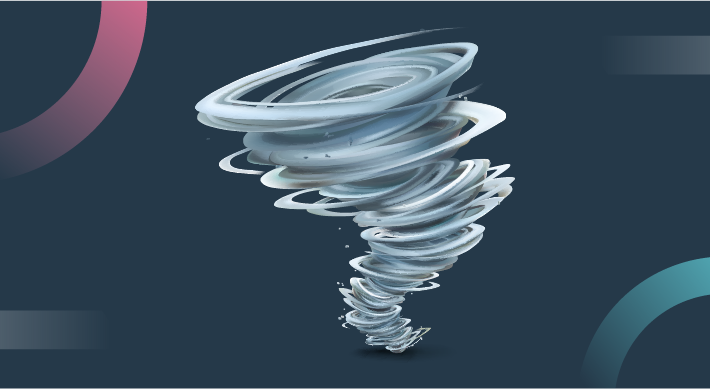How Claims Systems are Keeping the Catastrophe out of Catastrophe Claims
As the insurance industry faces increasing losses from natural catastrophes, see how the right claims system can help you handle sudden influx and large volume of claims.
Predicted losses from the recent Hurricane Ian, which hit Florida and South Carolina in the US in September, could alone reach as much as $75 billion. The RMS risk modelling company estimated total losses to private-market insureds at $53-74 billion, which includes losses from property damage, business interruption, as well as the impacts of post-event loss amplification, inflation, and non-modeled sources such as the assignment of benefits and litigation.
Hurricane Ian is just one catastrophic climate event (CAT event) out of many worldwide that have been shaking the insurance industry over the past years. Globally, insured losses from natural disasters, including hurricanes, floods, droughts, etc., reached $130 billion in 2021, well above the 21st century average of $74 billion, and 18% higher than in 2020, according to an Aon report.
Data from the Actuaries Climate Index (ACI), which details changes in the frequency of extreme climate events in the U.S. and Canada, points to an increased trend of more and stronger hurricanes and tornadoes, prolonged wildfire seasons, and heavier rainfall leading to increased flooding, exacerbated by population shifts to areas that may be more affected by these catastrophes. Deadly heatwaves in Canada, wildfires in California and Australia, catastrophic flooding in Europe and China, and more, were commonplace throughout 2021. These events are proliferating as a result of ongoing climate change and are impacting insurers, driving them to make changes to how they operate.
More catastrophic events, more catastrophe claims
For insurers, quite simply, the massive upswing in CAT events means significantly more claims by homeowners and commercial entities. With insurance claims comprising about 70% of insurance carriers’ total expenditures in payments, fraudulent losses, and processing costs, any optimization in losses paid and their associated expenses can have a material impact on insurers’ profitability. What this means is that an insurer’s claims handling and administration could easily make the difference between an underwriting profit and an underwriting loss.
So far in 2022, 29 billion-dollar weather disasters have already struck, according to an October report by Aon. Insured damage from tornadoes, hurricanes, severe storms, wildfires and other natural disasters reached $82 billion in the U.S. this year alone, before losses from Hurricane Ian are calculated. The implication for insurers is that they have to be able to quickly and efficiently manage the aftermath of high volume, high severity events.
The challenge to insurers in the face of catastrophic weather events
Many claims management systems today are auto-centric claims systems that have been modified to accommodate homeowner claims. Following a catastrophic weather even such as a hurricane or a flood, the demand for claims resolution spikes and customers need fast resolution. A cobbled together solution doesn’t cut it, and can intensify handling delays and resolution inaccuracies for customers who are in desperate need.
Understandably, high severity home losses (up to total rebuild or replacement of the home) are a uniquely negative experience for the homeowner and as result a difficult situation for claim adjusters resolving these losses. This has now been exacerbated by the relative prevalence of high severity weather events.
Insurers need dedicated, cloud-based SaaS claims solutions that are scalable and easy to deploy to fulfil the needs of a surge of customers making claims all at once.
A dedicated intelligent claims system for catastrophic times
Five Sigma’s claims management solution (CMS) for homeowner’s was conceived and built from the ground up to efficiently resolve homeowners’ insurance claims and to better manage the unexpected exponential increase in claim volume when catastrophe strikes.
When a severe weather event such as a tornado, hurricane or wild fire causes widespread damage, the insurer needs all hands on deck to ensure that insureds’ FNOL calls are answered, and reassurance is provided quickly. With Five Sigma, insurers can easily and without any coding add new users to the claims system in real time. In addition, with its intuitive FNOL user interface, non-claims users can be quickly trained to handle claims and begin assisting customers who are calling in.
As losses are taken and resolved across coverage or process queues, Five Sigma’s CMS automatically compiles, organizes, and presents all claims data in a usable format so that the insurer can recognize and forecast the size and scope of the event in real time as claims information is captured, and quickly understand what additional resource they need both internally and externally. The system enables the insurer to efficiently acquire and distribute these resources across the resolution process and relevant geography. The system also enables the insurer to create a portfolio of event-specific status reports that refresh in real time to proactively keep all internal and external parties informed.
Delivering value for homeowners’ insurance claims management
The Five Sigma claims solution offers insurers a flexible and intelligent way to handle the demands of claims resulting from CAT events:
- Automating claims submission: All FNOL data received from the insurers’ digital channels are automatically embedded into the system’s workflows and are ready for the next step in the process. The system ensure rapid system identification of claim types, automated triage and adjuster assignment.
- Providing just-in-time recommendations: The system flags coverage and liability issues and presents the adjuster with relevant information and investigative steps within the claims system.
- Improving decision making: Based on our advanced data modeling, we enable insurers to monitor your operations and receive actionable insights that will help you make strategic management decisions.
- Aiding in damage assessment and negotiation: The key to effectively negotiating a claim begins with accurate damage assessment. Our CMS includes a digital bodily injury evaluation module to itemize, assess and aggregate damages.
- Embedding omnichannel communications: Our CMS includes an API-level communication module that supports all types of communications including: SMS, mail, voice video calls, and even WhatsApp. All claims-related communication is documented, stored and analyzed automatically.
Conclusion
All data points to the undeniable fact that catastrophic climate events are on the rise and their frequency and staying power are a sad reality. For insurers, this means being prepared for sudden upswings of mass claims following a catastrophic event such as a hurricane, tornado, flood or wild fire. Without a scalable, easy to deploy that doesn’t require extra coding, insurers risk leaving their customers stranded in more ways than one. The Five Sigma CMS is the SaaS, cloud-based solution that ensures that insurers are ready for any event and provide their customers with the service and support they deserve after falling victim to disastrous climate events.
Click here to request a demo of Five Sigma’s intuitive claims management solution, and see for yourself why it’s a perfect solution for your homeowners line of business.



